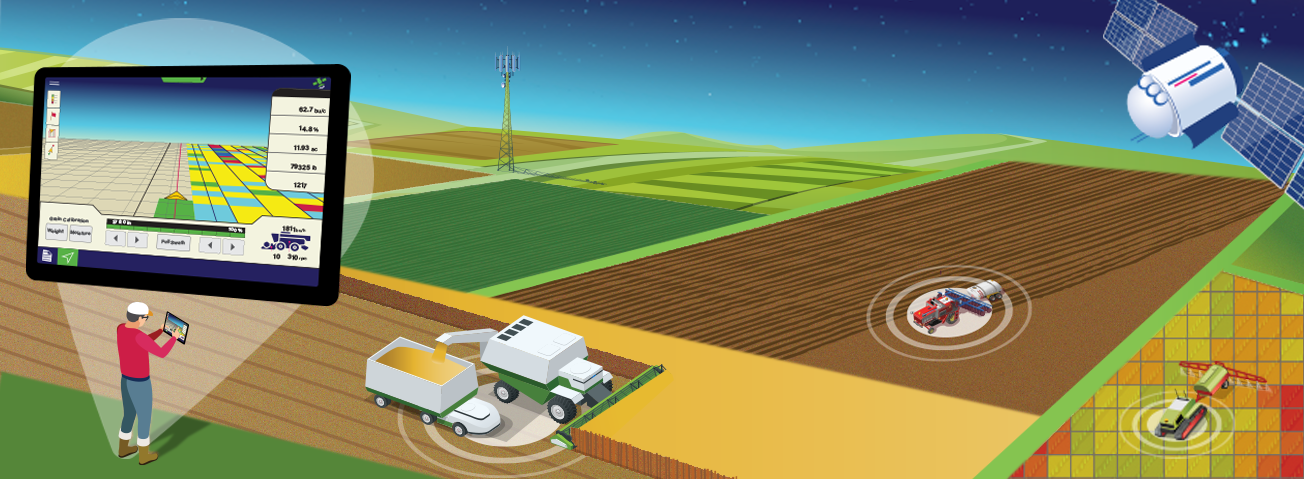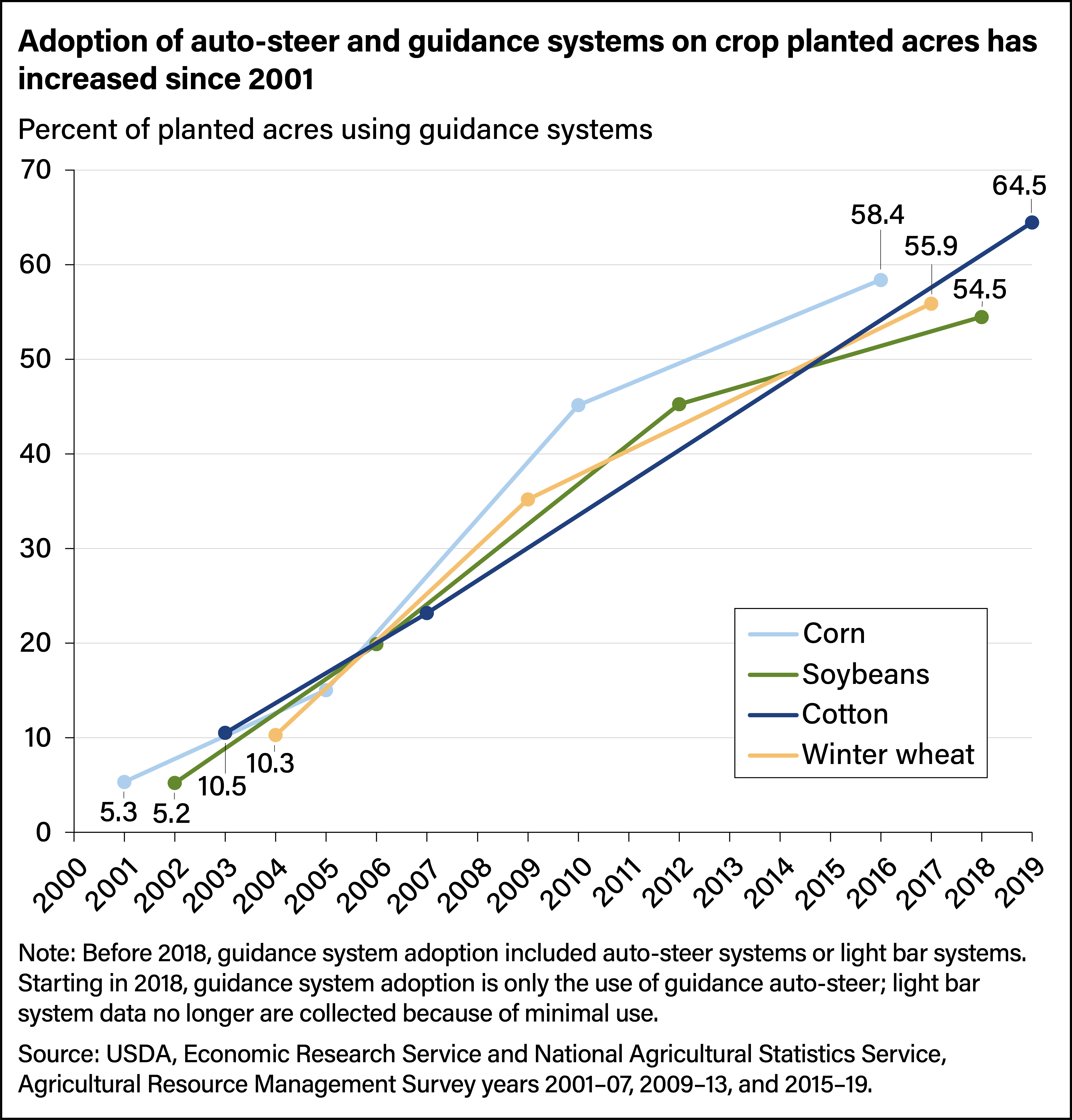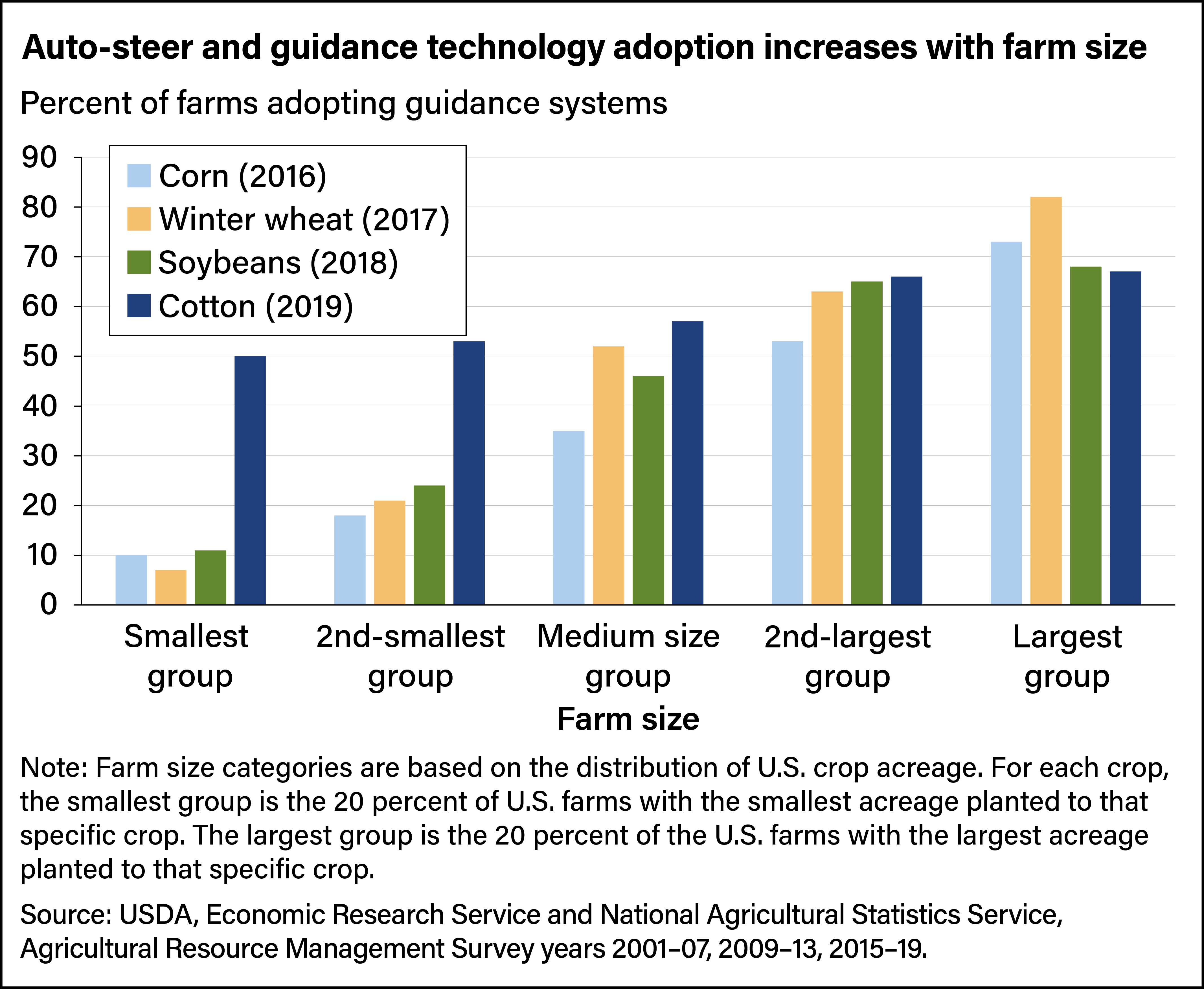
Most Row Crop Acreage Managed Using Auto-steer and Guidance Systems
- by Jonathan McFadden and Eric Njuki
- 4/3/2023
Highlights
- More than 50 percent of acres planted to corn, soybeans, cotton, and winter wheat are now managed with auto-steer and guidance systems.
- Guidance systems have multiple potential benefits, including decreased energy costs, lower input use because of increased efficiency, less soil compaction, and reduced operator fatigue.
- The proportion of farms adopting guidance systems increases with farm size.
Auto-steer and guidance systems use technologies that visualize and track the position of tractors, harvesters, and other equipment in real time. The main purpose of these systems is to reduce instances in which farmers unintentionally miss parts of their fields (known as “skips”) or make redundant passes through the field (“overlaps”). Such systems have evolved over time from “light bar” technologies that were semi-autonomous to more sophisticated systems that allow near-total automated steering. Today’s machines have the ability to use information from global navigation satellite systems, a general term that describes any satellite that provides positioning, navigation, and timing services, including global positioning systems (GPS). That ability allows for a high degree of precision in tracking exact locations in fields. Even so, their level of accuracy and precision depends on factors such as slope and terrain, the number of satellites in view at any point in time, and ionospheric activity, which can affect communication quality. Guidance systems come equipped in farm machinery or can be purchased separately and integrated with existing equipment. Their affordability and ease of installation, calibration, and use make them appealing to farm operators.
Although the basic accuracy of guidance systems is available through public navigation system signals at no cost, some equipment manufacturers provide added accuracy through cloud-based farm-management information systems that require an activation fee and paid subscription. In principle, greater locational accuracy allows for more efficient field operations and the potential to lower operational costs of production associated with seeding, tilling, and nutrient application by reducing overlaps and skips in the field. With fewer overlaps and skips, farmers can better assess the amount of inputs such as fuel, seed, nutrients, and pesticides they need.
In addition, autonomous steering permits automatically guided planting, tilling, fertilizing, and harvesting of crops with minimal involvement from the farmer. This frees up operator time in the cab for other farm management tasks such as checking weather reports or pricing information. Likewise, reduced in-cab time, as well as in-cab time that requires less exacting, minute-by-minute attention, decreases operator fatigue. Beyond these benefits, guidance systems can also help farmers decrease their environmental footprint by reducing soil compaction and fuel consumption and enabling precise application of nutrients.
Adoption of guidance systems tends to vary for several reasons, including field terrain, soil characteristics, costs (for subscription, training, maintenance, and equipment replacement), the scale and scope of production, and farmers’ risk preferences. Adoption also varies by type of crop and by farmer characteristics such as age, education level, and years of experience. As with most technology, producers were unfamiliar with guidance systems in early years, but as they learned about and gained more experience with the technology, the perceived benefits came into greater focus.
Adoption of auto-steer and guidance systems has increased in the past 20 years, with application on more than 50 percent of acreage planted to corn, soybeans, winter wheat, and cotton as of 2019. Adoption rates ranged from 54.5 percent of soybean acres in 2018 and 55.9 percent of winter wheat acres in 2017 to 58.4 percent of acres planted to corn in 2016, and 64.5 percent of cotton acres in 2019.
USDA, Economic Research Service researchers sorted farms into five equally sized groups based on farm acreage sizes. The groups varied according to commodity. For example, the first group, which characterizes farms with the smallest amount of acreage, included farms with 200 acres or fewer for corn but 1,150 acres or fewer for cotton. The researchers found that the largest farms across all commodities had adopted guidance at the highest rates. Specifically, of farms growing corn in 2016, 73 percent in the largest size category (1,725 acres or more) adopted guidance. The rates were similar for the group of largest farms growing other commodities in later years: 82 percent of the largest winter wheat farms in 2017 (3,140 acres or more), 68 percent of the largest soybean farms in 2018 (3,430 acres or more), and 67 percent of the largest cotton farms in 2019 (4,500 acres or more). Conversely, among the smallest farms, adoption of guidance systems was much lower: 10 percent of the smallest corn farms in 2016 (200 acres or fewer), 7 percent of the smallest winter wheat farms in 2017 (300 acres or fewer), and 11 percent of the smallest soybean farms in 2018 (310 acres or fewer), with the exception of cotton, which starts at a relatively high rate of 50 percent for the smallest cotton farms in 2019 (1,150 acres or fewer).
Auto-steer and guidance systems can be synchronized with other devices such as tablets and smartphones, which can be used as display terminals. The systems can be portable, allowing farmers to move them between vehicles. The level of sophistication varies, making them accessible to farmers with various skill levels and to farms of various sizes and capital outlays. These factors mean guidance systems have the potential to bring the same kinds of benefits—though not necessarily at the same magnitude—to small and medium-sized farms that have been available to larger farms. However, if farmers do not think they can spread the costs of guidance systems over a large enough cropland base and earn enough revenue, they may choose not to adopt.
Similarly, availability of broadband or other internet access is a key requirement for precision agriculture technologies. Indeed, a lack of internet access has been identified as a major barrier to adoption, and Government programs seek to expand access to broadband by financing its provision and related infrastructure. These programs include the USDA’s Community Connected/Reconnect Grants, the Farm Bill Broadband Program, and the Telecommunications Infrastructure Loans and Guarantee Program. While these programs do not directly pay farmers to adopt or to improve their adoption of digital technologies, they may make it easier for farmers to try them.
This article is drawn from:
- McFadden, J., Njuki, E. & Griffin, T. (2023). Precision Agriculture in the Digital Era: Recent Adoption on U.S. Farms. U.S. Department of Agriculture, Economic Research Service. EIB-248.
You may also like:
- Schimmelpfennig, D. (2016). Farm Profits and Adoption of Precision Agriculture. U.S. Department of Agriculture, Economic Research Service. ERR-217.
- Schimmelpfennig, D. & Ebel, R. (2011). On the Doorstep of the Information Age: Recent Adoption of Precision Agriculture. U.S. Department of Agriculture, Economic Research Service. EIB-80.



